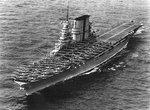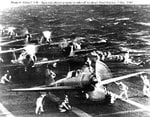parsifal
Colonel
Taihos loss is a story of what not to do in damage control. The ship began to fill with vapoure, and rather than keep the ships watertight doors closed, the DC officer decided to open everything up to try and clear out the vapor. A stupid decision if ever there was one. It is believed that a spark from an arcing generator provided the ignition, and the carrier, with its fuel well oxygenated, exploded as a bomb.
by 1944, there were manpower shortages in the Japanese fleet generally, not just the aircrews, and with inadequate crew numbers, it was the DC crews that tended to suffer cutbacks before anyone. Training was also cut back severely, and lastly, of course, the fuls pumped into the ships was unprocessed and too high in octane to be used safely. Japan lacked the shipping, particulalry tankers, to ship the oil back to japan, process it properly and return it to the front. A major reason why most of her battle line spent the war swinging around its anchor chains in Japanese ports. US had similar problems early on, so early deletions fro the TOand E of the active US fleet were the older BBs. They were too slow and too fuel hungry to be usefeul. later, they found a use as bombardment platforms, but that came quite a bit later.
The American submarine fleet probably did more to destroy the Japanese fleet than any other single arm of the USN. And they did it not by direct fleet support, but a crippling blockade, for which Japan had no answer and no effective defence.
by 1944, there were manpower shortages in the Japanese fleet generally, not just the aircrews, and with inadequate crew numbers, it was the DC crews that tended to suffer cutbacks before anyone. Training was also cut back severely, and lastly, of course, the fuls pumped into the ships was unprocessed and too high in octane to be used safely. Japan lacked the shipping, particulalry tankers, to ship the oil back to japan, process it properly and return it to the front. A major reason why most of her battle line spent the war swinging around its anchor chains in Japanese ports. US had similar problems early on, so early deletions fro the TOand E of the active US fleet were the older BBs. They were too slow and too fuel hungry to be usefeul. later, they found a use as bombardment platforms, but that came quite a bit later.
The American submarine fleet probably did more to destroy the Japanese fleet than any other single arm of the USN. And they did it not by direct fleet support, but a crippling blockade, for which Japan had no answer and no effective defence.
Last edited:


